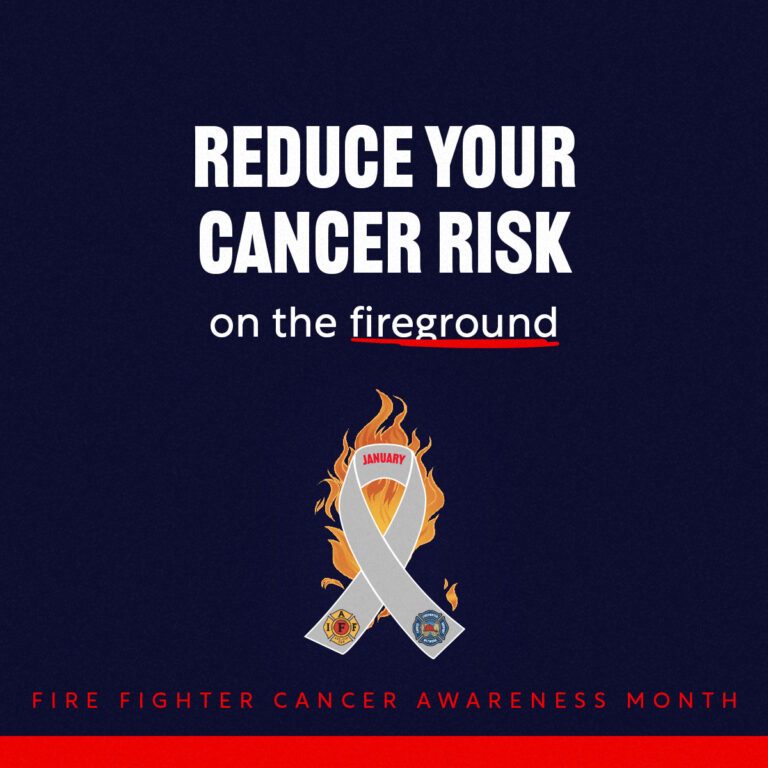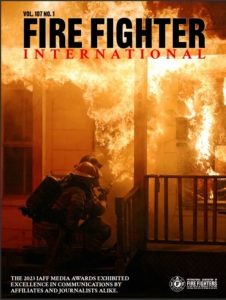
Fire fighters are occupationally exposed to combustion byproducts while operating in various fire settings. These may include modern residential, commercial, vehicle, wildland, and other fires that contain many hazardous substances and increase the risk of fire fighters being exposed to these toxic chemicals.
There are a few best practices to reduce cancer on the fireground, but the best way to reduce your exposures on the fireground is to wear your self-contained breathing apparatus (SCBA) from the start of suppression through overhaul. Fire investigators, if possible, should also wear their SCBA. It is the gold standard for respiratory protection.
Designate Zones on the Fireground
To reduce these exposures, similar to exposure zones in fire stations, it is recommended to establish hot, warm, and cold zones on the fireground. Creating and managing these three zones can help reduce exposure to carcinogens during fire responses.
Hot Zone: Immediate Perimeter of Any Fire
There are a few best practices to reduce cancer on the fireground, but the best way to reduce your exposures on the fireground is to wear your self-contained breathing apparatus (SCBA) from the start of suppression through overhaul. Fire investigators, if possible, should also wear their SCBA. It is the gold standard for respiratory protection.
Warm Zone: Transition Zone
The warm zone is the area between the hot zone and the cold zone. This area is not in the immediate perimeter of any fire or products of combustion. Preliminary exposure reduction (PER) occurs in the warm zone, where personnel should be using SCBA and be on-air. The warm zone also serves as the drop zone for doffing/dropping of equipment prior to entering rehab or bagging contaminated PPE and equipment. Nourishment should not occur in the warm zone in order to decrease ingestion of carcinogens.
Cold Zone: Non-Hazardous Area
The cold zone is any area outside of the hot and warm zones. It is also the control zone of an incident that contains the command post and other support functions as deemed necessary. The cold zone will ideally be located uphill and upwind from the fire scene. Rehabilitation or rehab should be located in the cold zone. Nourishment should occur in the rehabilitation area or the cold zone.
Preliminary Exposure Reduction and Bagging Gear
- Preliminary exposure reduction (PER) reduces polycyclic aromatic hydrocarbons (PAH’s) by 85% on PPE and equipment. PER also drastically decreases a firefighter’s exposure to contaminants on their gear and equipment that may continue to off-gas or may become airborne as you travel back to the station.
- Anyone, including fire investigators, who are exposed to products of combustion need to go through PER.
- Prior to doffing firefighting gear, PER should be performed to remove potentially harmful contaminants, which is outlined in NFPA 1500 and 1851.
- Wet wipes should be used to wipe all areas of exposed skin.
- Tools and equipment should be cleaned at the scene.
GAHANNA GIFT SHOP
miscLocal 2818 and Mifflin Fire are proud to partner with our friends and colleagues at Gahanna Police to participate in the 8th Annual Gahanna Gift Shop. This program will help to get Christmas presents to those in our community who might be in need of assistance. Donating is easy! Visit gahannagiftshop.com or use the QR code to go to the shopping list. There are items there that fit most price points.
Thank you for participating and helping our fellow community members this Holiday Season! A PDF version of this flyer can be downloaded by clicking on this link .
CLICK THE FLYER TO ENLARGE
New FFI Available
NewsThe newest edition of IAFF’s FFI is available from the Members Area of this website. Login required.
Survivor Story: Mary Blaul, Orange County CA, Local 3631
NewsSurvivor Story: Larry Zuber: Evansville, IN Local 357
NewsSurvivor Story: Ian Da Costa: Laguna Beach CA L3684
NewsCALL TO ACTION: OFF DUTY
NewsSo, taking care of yourself off duty is just as important as in the station or on a call. Go easy with the alcohol. SMOKING IS BAD FOR YOU (unless it’s at the barbecue). Get your screenings done. Stay active. Try to keep a standard sleeping schedule. And, yes, naps are okay. And, your brain is a muscle, too. Take care of it; you only get one. Clicking on the thumbnail below opens a PDF with easy to implement
nap schedulesthings to keep yourself in good shape for the job, for your crew, for your family, FOR YOU.Best Practices Off the Job
NewsThe risk factors most linked to increased cancer rates include numerous modifiable factors. Knowing and making small changes can reduce cancer risks significantly. For example, quitting tobacco before the age of 40 reduces the risk of dying from smoking-related diseases by 90%. Alcohol and tobacco consumption, obesity/diet, and sunlight exposure can all help mitigate (or worsen) a Member’s risk factors both on and off the job. Stress and sleep (or lack thereof) also play a factor.
Your occupational exposures cannot change, but you can adopt safer policies and habits to reduce your exposure to toxic chemicals. Off duty there are additional factors that can increase your risk of developing cancer. While some risk factors cannot be avoided, others can be modified to promote health. Knowing the risk and modifying lifestyles can in many ways provide a buffer to the occupational exposure fire fighters in various situations cannot be avoided.
The below thumbnail links to a PDF file of easy-to-implement things to help you stay healthy off the job (and thereby, too, on the job).
CALL TO ACTION: Awareness on the Fireground
NewsEasy to implement instructions on how to reduce your cancer risk before the fire, on the fireground, and after the fire. The image above links to a downloadable pdf.
FIREFIGHTER CANCER AWARENESS MONTH
NewsFire fighters are occupationally exposed to combustion byproducts while operating in various fire settings. These may include modern residential, commercial, vehicle, wildland, and other fires that contain many hazardous substances and increase the risk of fire fighters being exposed to these toxic chemicals.
There are a few best practices to reduce cancer on the fireground, but the best way to reduce your exposures on the fireground is to wear your self-contained breathing apparatus (SCBA) from the start of suppression through overhaul. Fire investigators, if possible, should also wear their SCBA. It is the gold standard for respiratory protection.
Designate Zones on the Fireground
To reduce these exposures, similar to exposure zones in fire stations, it is recommended to establish hot, warm, and cold zones on the fireground. Creating and managing these three zones can help reduce exposure to carcinogens during fire responses.
Hot Zone: Immediate Perimeter of Any Fire
There are a few best practices to reduce cancer on the fireground, but the best way to reduce your exposures on the fireground is to wear your self-contained breathing apparatus (SCBA) from the start of suppression through overhaul. Fire investigators, if possible, should also wear their SCBA. It is the gold standard for respiratory protection.
Warm Zone: Transition Zone
The warm zone is the area between the hot zone and the cold zone. This area is not in the immediate perimeter of any fire or products of combustion. Preliminary exposure reduction (PER) occurs in the warm zone, where personnel should be using SCBA and be on-air. The warm zone also serves as the drop zone for doffing/dropping of equipment prior to entering rehab or bagging contaminated PPE and equipment. Nourishment should not occur in the warm zone in order to decrease ingestion of carcinogens.
Cold Zone: Non-Hazardous Area
The cold zone is any area outside of the hot and warm zones. It is also the control zone of an incident that contains the command post and other support functions as deemed necessary. The cold zone will ideally be located uphill and upwind from the fire scene. Rehabilitation or rehab should be located in the cold zone. Nourishment should occur in the rehabilitation area or the cold zone.
Preliminary Exposure Reduction and Bagging Gear
FIREFIGHTER CANCER AWARENESS MONTH
NewsFire fighter occupational cancer is the leading cause of line-of-duty death in the fire service.
At the 2023 IAFF Fallen Fire Fighter Memorial, 63% of the names added to the wall were members who had died from occupational cancer.
In partnership with the Firefighter Cancer Support Network (FCSN), the IAFF has designated January as Fire Fighter Cancer Awareness Month to provide fire fighters the necessary tools and guidance to develop life-saving protocols for cancer prevention and to support those with a cancer diagnosis within their departments.
Bringing increased public awareness to occupational cancer in the fire service will help generate greater legislative support for states and provinces to establish presumptive disabilities for all cancers affecting fire fighters.